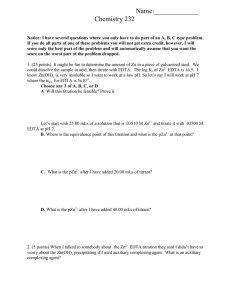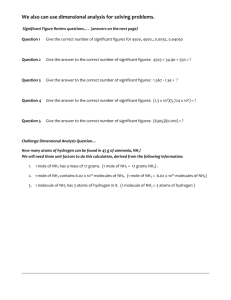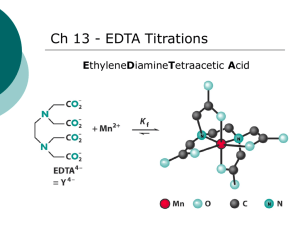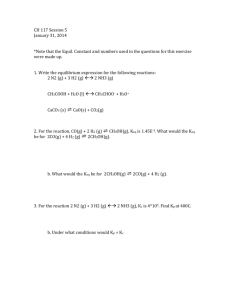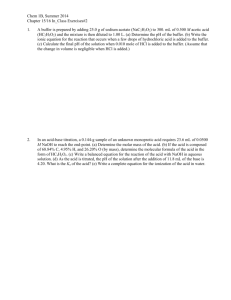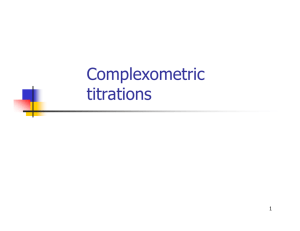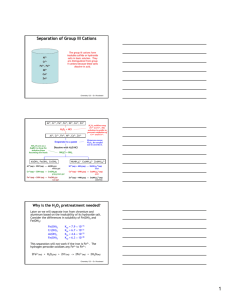Question 2
advertisement
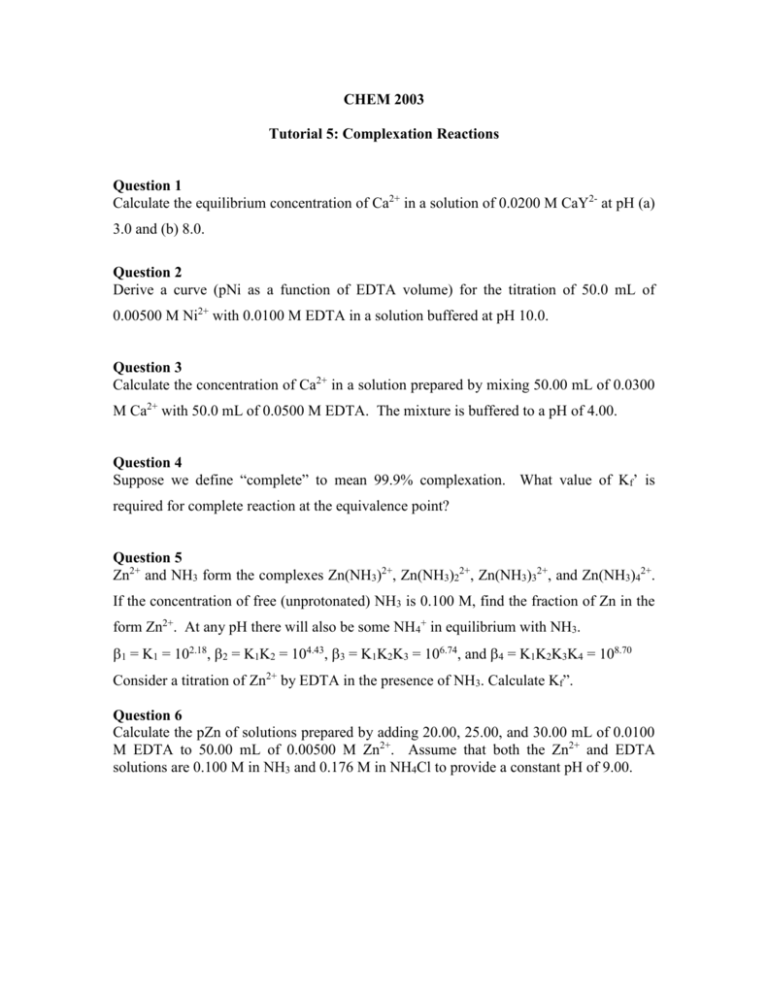
CHEM 2003 Tutorial 5: Complexation Reactions Question 1 Calculate the equilibrium concentration of Ca2+ in a solution of 0.0200 M CaY2- at pH (a) 3.0 and (b) 8.0. Question 2 Derive a curve (pNi as a function of EDTA volume) for the titration of 50.0 mL of 0.00500 M Ni2+ with 0.0100 M EDTA in a solution buffered at pH 10.0. Question 3 Calculate the concentration of Ca2+ in a solution prepared by mixing 50.00 mL of 0.0300 M Ca2+ with 50.0 mL of 0.0500 M EDTA. The mixture is buffered to a pH of 4.00. Question 4 Suppose we define “complete” to mean 99.9% complexation. What value of Kf’ is required for complete reaction at the equivalence point? Question 5 Zn2+ and NH3 form the complexes Zn(NH3)2+, Zn(NH3)22+, Zn(NH3)32+, and Zn(NH3)42+. If the concentration of free (unprotonated) NH3 is 0.100 M, find the fraction of Zn in the form Zn2+. At any pH there will also be some NH4+ in equilibrium with NH3. 1 = K1 = 102.18, 2 = K1K2 = 104.43, 3 = K1K2K3 = 106.74, and 4 = K1K2K3K4 = 108.70 Consider a titration of Zn2+ by EDTA in the presence of NH3. Calculate Kf”. Question 6 Calculate the pZn of solutions prepared by adding 20.00, 25.00, and 30.00 mL of 0.0100 M EDTA to 50.00 mL of 0.00500 M Zn2+. Assume that both the Zn2+ and EDTA solutions are 0.100 M in NH3 and 0.176 M in NH4Cl to provide a constant pH of 9.00. Tutorial 6: Redox Reactions Question 1 Balance the following redox equations, supplying H+, OH-, and H2O as required: (a) V2+ + V(OH)4+ = VO2+ (basic medium) 2+ 3+ (b) Zn + H2MoO4 = Zn + Mo (acid medium) (c) P4 + HOCl = H3PO4 + Cl(Acid medium) (d) Cr(OH)4- + BrO- = CrO42- + Br(basic medium) (e) C2O42- + MnO4- = CO2 + Mn2+ (acid medium) Question 2 1 The free energy change for the reaction CO O2 CO2 is ΔGo = -257 kJ/mol of CO at 2 298 K. (a) Find Eo for the reaction. (b) Find the equilibrium constant for the reaction. Question 3 A solution contains 0.100 M Ce3+, 1.00 * 10-4 M Ce4+, 1.00 * 10-4 M Mn2+, 0.100 M MnO4-, and 1.00 M HClO4. (a) Write a balanced net reaction that can occur between the species in this solution. o o 1.507V ECe 1.70V , and E MnO 4 / Mn 2 / Ce 3 4 (b) Calculate ΔGo and K for the reaction. (c) Calculate E for the conditions given above. (d) Calculate ΔG for the conditions given above. At what pH would the concentrations of Ce4+, Ce3+, Mn2+, and MnO4- listed above be in equilibrium at 298 K? Tutorial 7: Gravimetric analysis and Precipitation Reactions Question 1 To find the Ce4+ content of a solid, 4.37 g were dissolved and treated with excess iodate to precipitate Ce(IO3)4. The precipitate was collected, washed well, dried, and ignited to produce 0.104 g of CeO2 (MW = 172.114 gmol-1). What was the weight percent of Ce in the original solid? Question 2 Given a 0.4500g sample of a hydrate of BaCl2-2H2O. The Cl- was precipitated with 38.88ml of a 0.1000M AgNO3. What would be the % composition of the sample in BaCl2 if the discrepancy was due to the partial hydration of the BaCl2 ? Question 3 100 mL of 0.100 M KI is titrated with 0.500 M AgNO3. Calculate the pAg following addition of 10 mL, 20 mL and 30 mL of titrant. Question 4 Consider a 1.000 g sample that contains 75% potassium sulfate (FW 174.25) and 25% MSO4. The sample is dissolved and the sulfate precipitated as barium sulfate (FW 233.39). If the barium sulfate precipitate weighs 1.4900 g, what is the atomic weight of M2+ in MSO4. Question 5 A mixture of mercurous chloride (FW 472.09) and mercurous bromide (FW 560.99) weighs 2.00 g. The mixture is quantitatively reduced to mercury metal which weighs 1.59 g. Calculate the percent mercurous chloride and mercurous bromide in the original mixture.
